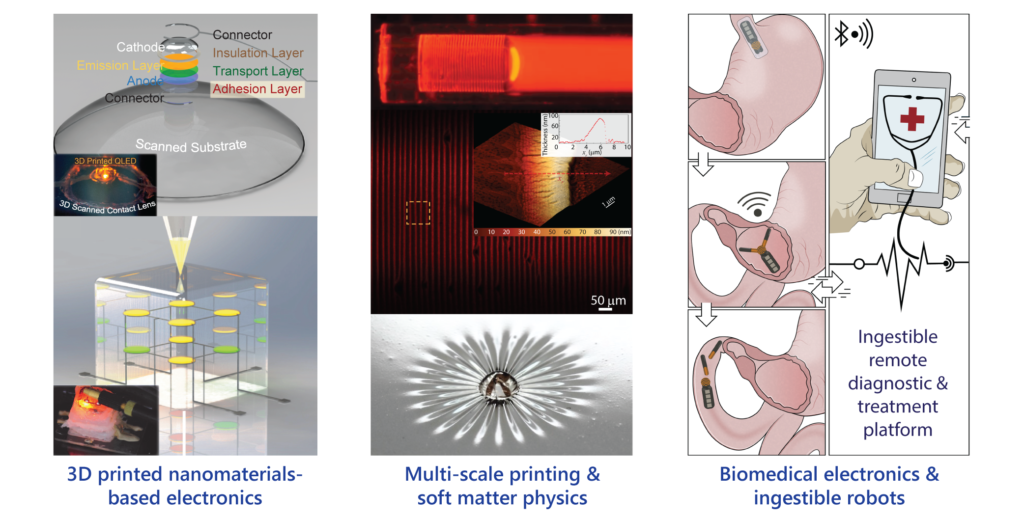3D printing, also known as additive manufacturing, has enabled exciting advancements in a broad range of areas. Assistant professor Yong Lin Kong is pushing the boundary of 3D printing to develop fundamentally transformative technologies that can overcome geometrical, mechanical, and material dichotomies between conventional manufacturing techniques and a broad range of three-dimensional systems. These advancements enable the creation of 3D functional devices and architecture with a wide range of applications including remote manufacturing of electronics and advancing soft robotics to address unmet clinical needs.
Kong’s work allows seamless integration of active electronics and devices (including but not limited to optoelectronics, transistors, etc.) onto a wide range of three-dimensional constructs. Some examples of what this can help create include the integration of active electronics into existing biomedical devices such as implants and prostheses and the creation of multifunctional constructs seamlessly incorporated with active electronics via a multi-material 3D printing approach.

One area Kong’s group is currently studying is 3D printing electronics into FDA-approved medical implants in collaboration with clinical collaborators. Kong recently received an NIH Trailblazer Award to establish this work with orthopedic surgeons and researchers, developing advanced sensing electronics that can be printed into existing total joint replacement implants.
“We envision that the ability to seamlessly integrate sensing electronics into implants will enable the acquisition of previously unavailable longitudinal data,” said Kong. “This data will help us to better understand both biomechanics and implant failure, providing important data to improve future implants.”
Another area Kong is working in is the integration of nanomaterials with an extrusion-based 3D printing process to create a wide range of transformable mesoscale (structures that can reach up to centimeters in overall size but retain micro- or nano-features) architecture. This can potentially help create biomedical devices that can address unmet clinical needs. One example of that work is Kong’s invention “gastric resident electronics (GRE).” This is a 3D printed electronic that can be folded into the shape of a capsule. Once ingested and exposed to gastric fluid in the gastric space, the device can expand into a robust mechanical configuration that helps it stay longer in those spaces. This, for the first time, enables a surgery-free delivery of long residence electronics to a dynamic and hostile gastric environment, allowing treatments that leverage the stomach’s immune-privileged property.
Kong’s team is also studying the integration of ferromagnetic nanomaterials with a magnetic 3d printing process that will allow them to create magnetoactive mesoscale soft robots. The multi-materials extrusion printing approach would also enable seamless integration with other functional sensing electronics and actuators. This could allow for the ability to telemanipulate soft robots that can transverse in the human body, allowing for surgery-free or minimally invasive medical operations for biopsy, drug delivery, or even tumor removal.
 “We are extremely excited for the opportunity to establish a fundamentally new multiscale 3D printing approach that can overcome the long-standing challenges in the integration of electronics with three-dimensional systems to functionalize an otherwise passive construct,” Kong said. “Once established, the fundamentally new research direction can address a broad range of unmet clinical needs.”
“We are extremely excited for the opportunity to establish a fundamentally new multiscale 3D printing approach that can overcome the long-standing challenges in the integration of electronics with three-dimensional systems to functionalize an otherwise passive construct,” Kong said. “Once established, the fundamentally new research direction can address a broad range of unmet clinical needs.”
You can learn more about Kong’s work through the Additive Manufacturing Laboratory website: https://kong.mech.utah.edu/